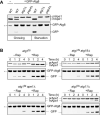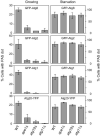Cargo proteins facilitate the formation of transport vesicles in the cytoplasm to vacuole targeting pathway
- PMID: 15138258
- PMCID: PMC1712665
- DOI: 10.1074/jbc.M404399200
Cargo proteins facilitate the formation of transport vesicles in the cytoplasm to vacuole targeting pathway
Abstract
Selective incorporation of cargo proteins into the forming vesicle is an important aspect of protein targeting via vesicular trafficking. Based on the current paradigm of cargo selection in vesicular transport, proteins to be sorted to other organelles are condensed at the vesicle budding site in the donor organelle, a process that is mediated by the interaction between cargo and coat proteins, which constitute part of the vesicle forming machinery. The cytoplasm to vacuole targeting (Cvt) pathway is an unconventional vesicular trafficking pathway in yeast, which is topologically and mechanistically related to autophagy. Aminopeptidase I (Ape1) is the major cargo protein of the Cvt pathway. Unlike the situation in conventional vesicular transport, precursor Ape1, along with its receptor Atg19/Cvt19, is packed into a huge complex, termed a Cvt complex, independent of the vesicle formation machinery. The Cvt complex is subsequently incorporated into the forming Cvt vesicle. The deletion of APE1 or ATG19 compromised the organization of the pre-autophagosomal structure (PAS), a site that is thought to play a critical role in Cvt vesicle/autophagosome formation. The proper organization of the PAS also required Atg11/Cvt9, a protein that localizes the cargo complex at the PAS. Accordingly, the deletion of APE1, ATG19, or ATG11 affected the formation of Cvt vesicles. These observations suggest a unique concept; in the case of the Cvt pathway, the cargo proteins facilitate receptor recruitment and vesicle formation rather than the situation with most vesicular transport, in which the forming vesicle concentrates the cargo proteins.
Figures



Similar articles
-
Atg11 links cargo to the vesicle-forming machinery in the cytoplasm to vacuole targeting pathway.Mol Biol Cell. 2005 Apr;16(4):1593-605. doi: 10.1091/mbc.e04-11-1035. Epub 2005 Jan 19. Mol Biol Cell. 2005. PMID: 15659643 Free PMC article.
-
Aspartyl aminopeptidase is imported from the cytoplasm to the vacuole by selective autophagy in Saccharomyces cerevisiae.J Biol Chem. 2011 Apr 15;286(15):13704-13. doi: 10.1074/jbc.M110.173906. Epub 2011 Feb 22. J Biol Chem. 2011. PMID: 21343297 Free PMC article.
-
Mechanism of cargo selection in the cytoplasm to vacuole targeting pathway.Dev Cell. 2002 Dec;3(6):825-37. doi: 10.1016/s1534-5807(02)00373-8. Dev Cell. 2002. PMID: 12479808 Free PMC article.
-
Molecular machinery required for autophagy and the cytoplasm to vacuole targeting (Cvt) pathway in S. cerevisiae.Curr Opin Cell Biol. 2002 Aug;14(4):468-75. doi: 10.1016/s0955-0674(02)00343-5. Curr Opin Cell Biol. 2002. PMID: 12383798 Review.
-
Transport of proteins to the yeast vacuole: autophagy, cytoplasm-to-vacuole targeting, and role of the vacuole in degradation.Semin Cell Dev Biol. 2000 Jun;11(3):173-9. doi: 10.1006/scdb.2000.0163. Semin Cell Dev Biol. 2000. PMID: 10906274 Review.
Cited by
-
The histone H4 lysine 16 acetyltransferase hMOF regulates the outcome of autophagy.Nature. 2013 Aug 22;500(7463):468-71. doi: 10.1038/nature12313. Epub 2013 Jul 17. Nature. 2013. PMID: 23863932 Free PMC article.
-
Tissue-specific autophagy responses to aging and stress in C. elegans.Aging (Albany NY). 2015 Jun;7(6):419-34. doi: 10.18632/aging.100765. Aging (Albany NY). 2015. PMID: 26142908 Free PMC article.
-
Lipid droplets and their component triglycerides and steryl esters regulate autophagosome biogenesis.EMBO J. 2015 Aug 13;34(16):2117-31. doi: 10.15252/embj.201490315. Epub 2015 Jul 10. EMBO J. 2015. PMID: 26162625 Free PMC article.
-
Fission Yeast Autophagy Machinery.Cells. 2022 Mar 24;11(7):1086. doi: 10.3390/cells11071086. Cells. 2022. PMID: 35406650 Free PMC article. Review.
-
The carboxy terminus of yeast Atg13 binds phospholipid membrane via motifs that overlap with the Vac8-interacting domain.Autophagy. 2020 Jun;16(6):1007-1020. doi: 10.1080/15548627.2019.1648117. Epub 2019 Aug 2. Autophagy. 2020. PMID: 31352862 Free PMC article.
References
Publication types
MeSH terms
Substances
Grants and funding
LinkOut - more resources
Full Text Sources
Molecular Biology Databases
Research Materials
Miscellaneous

